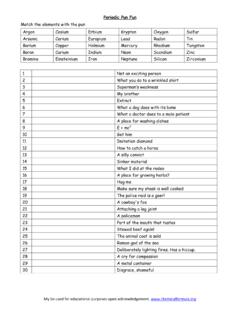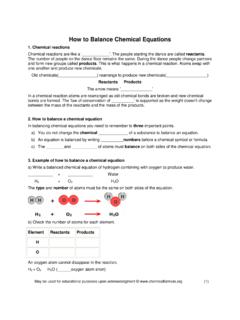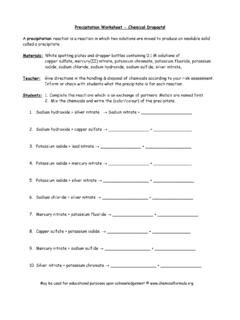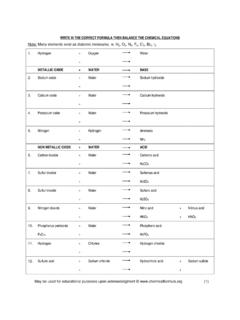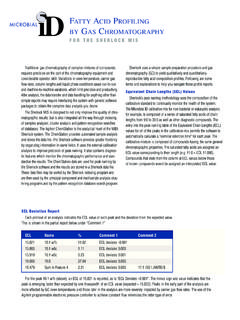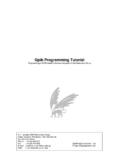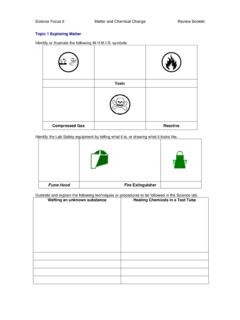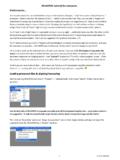Transcription of HOW TO NAME COVALENT COMPOUNDS? - Chemical Formula
1 HOW TO name COVALENT COMPOUNDS? COVALENT compounds are produced by non metallic elements bonding with one another. Eg. Water, H2O. Valencies can be used to determine the Formula of some COVALENT compounds. Determine the Chemical Formula of compounds formed between the following pairs of non-metallic elements using valencies. Elements H&O N&H N&O C&O P&F. compound The Chemical formulas of many molecules however, cannot be determined by using valencies. eg. H2O2, N2H4, NO, NO2, CO and PF5. Romans numerals can be used but often fail to distinguish between some molecular compounds. eg. NO2 is nitrogen(IV) oxide and N2O4 is nitrogen(IV) oxide. Another system of naming is needed. RULES FOR NAMING COVALENT COMPOUNDS. 1. Prefixes are added according to the molecular Formula . Fill in the table with the correct number.
2 Mono di tri tetra penta hexa hepta octa nona deca 2. The most non-metallic element has the ide suffix. Determine which element has the suffix? * Across a period the elements become (more/ less) non-metallic. eg. Sulfur and chlorine _____. eg. Boron and fluorine _____. * Down a group the element become (more/ less) metallic. eg. Chlorine and fluorine _____. eg. Carbon and silicon _____. 3. There is no mono for the first name , ONLY for the second. eg. Carbon monoxide and is not monocarbon monoxide * Sometimes the mono is also left out in the second name . eg. NO, nitrogen monoxide is sometimes called nitrogen oxide. 4. Where the suffix ends in an a or an o and the element begins with an a or an o , the final vowel of the prefix is often dropped for ease of pronunciation. eg. Carbon monoxide and not carbon monooxide eg.
3 Dinitrogen tetroxide and not dinitrogen tetraoxide Note: Phosphorous triiodide remains unchanged. Sulfur tetraiodide remains unchanged. 5. Some substances still retain their common names eg. H2O is water and not dihydrogen monoxide eg. H2O2 is hydrogen peroxide and not _____. eg. NH3 is ammonia and not _____. May be used upon acknowledgement. name THE FOLLOWING COVALENT COMPOUNDS. name Chemical Formula 1. Sulfur dioxide 2. SiO2. 3. SO3. 4. SCl2. 5. Nitrogen trifluoride 6. N2O3. 7. Dinitrogen pentoxide 8. Cl2O7. 9. Carbon(IV) oxide*. 10. Disulfur dichloride 11. CO. 12. N2O4. 13. NO2. 14. Nitrogen(I) oxide*. 15. Nitrogen monoxide 16. PF3. 17. Phosphorus(III) chloride*. 18. SF6. 19. BI3. 20. Tricarbon disulfide *Hint: Romans numerals are used to tell us the combining power of an element. Use the arm and link method to determine the Chemical Formula for these compounds first.
4 Which element is given the ide suffix? The most electronegative (or non-metallic) element. May be used upon acknowledgement. HOW TO name COVALENT COMPOUNDS? ANSWERS. COVALENT compounds are produced by non metallic elements bonding with one another. Eg. Water, H2O. Valencies can be used to determine the Formula of some COVALENT compounds. Determine the Chemical Formula of compounds formed between the following pairs of non-metallic elements using valencies. Elements H&O N&H N&O C&O P&F. compound H2O NH3 N2O3 CO2 PF3. The Chemical formulas of many molecules however, cannot be determined by using valencies. eg. H2O2, N2H4, NO, NO2, CO and PF5. Romans numerals can be used but often fail to distinguish between some molecular compounds. eg. NO2 is nitrogen(IV) oxide and N2O4 is nitrogen(IV) oxide. Another system of naming is needed.
5 RULES FOR NAMING COVALENT COMPOUNDS. 1. Prefixes are added according to the molecular Formula . Fill in the table with the correct number. mono di tri tetra penta hexa hepta octa nona deca 1 2 3 4 5 6 7 8 9 10. 2. The most non-metallic element has the ide suffix. Determine which element has the suffix? * Across a period the elements become (more/ less) non-metallic. eg. Sulfur and chlorine. chloride suffix eg. Boron and fluorine. fluoride suffix * Down a group the element become (more/ less) metallic. eg. Chlorine and fluorine. fluoride suffix eg. Carbon and silicon. carbide suffix 3. There is no mono for the first name , ONLY for the second. eg. Carbon monoxide and is not monocarbon monoxide * Sometimes the mono is also left out in the second name . eg. NO, nitrogen monoxide is sometimes called nitrogen oxide.
6 4. Where the suffix ends in an a or an o and the element begins with an a or an o , the final vowel of the prefix is often dropped for ease of pronunciation. eg. Carbon monoxide and not carbon monooxide eg. dinitrogen tetroxide and not dinitrogen tetraoxide Note: Phosphorous triiodide remains unchanged. Sulfur tetraiodide remains unchanged. 5. Some substances still retain their common names eg. H2O is water and not dihydrogen monoxide eg. H2O2 is hydrogen peroxide and not dihydrogen dioxide eg. NH3 is ammonia and not nitrogen trihydride May be used upon acknowledgement. name THE FOLLOWING COVALENT COMPOUNDS - ANSWERS. name Chemical Formula 1. Sulfur dioxide SO2. 2. Silicon dioxide SiO2. 3. Sulfur trioxide SO3. 4. Sulfur dichloride SCl2. 5. Nitrogen trifluoride NF3. 6. Dinitrogen trioxide N2O3. 7. Dinitrogen pentoxide N2O5.
7 8. Dichlorine heptoxide Cl2O7. 9. Carbon dioxide CO2 Carbon(IV) oxide*. 10. Disulfur dichloride S2Cl2. 11. Carbon monoxide CO. 12. Dinitrogen tetroxide N2O4. 13. Nitrogen dioxide NO2. 14. Dinitrogen monoxide N2O Nitrogen(I) oxide*. 15. Nitrogen monoxide NO. 16. Phosphorus trifluoride PF3. 17. Phosphorus trichloride PCl3 Phosphorus(III) chloride*. 18. Sulfur hexafluoride SF6. 19. Boron triiodide BI3. 20. Tricarbon disulfide C3S2. *Hint: Romans numerals are used to tell us the combining power of an element. Use the arm and link method to determine the Chemical Formula for these compounds first. Which element is given the ide suffix? The most electronegative (or non-metallic) element. May be used upon acknowledgement.
